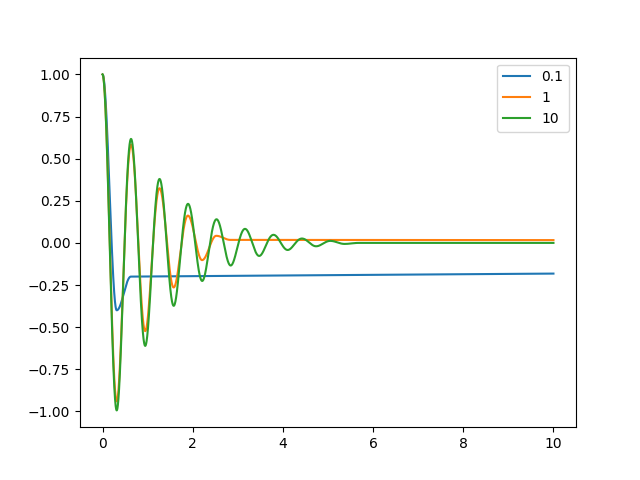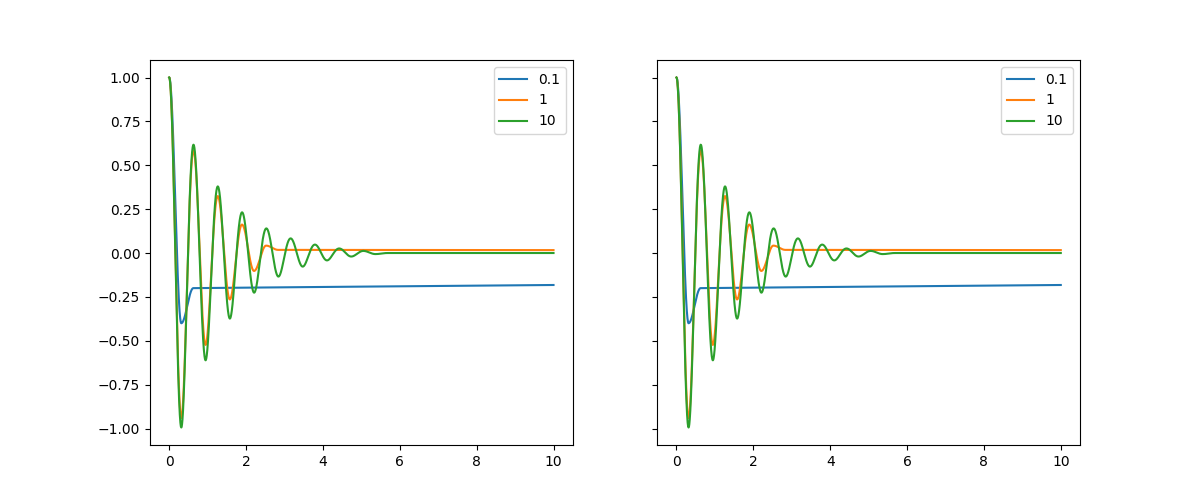Numba Example¶
JIT-compiled (thread) parallel python code: https://gist.github.com/safijari/fa4eba922cea19b3bc6a693fe2a97af7
We want to solve a silly version of the (under) damped spring-mass problem

In [2]:
def friction_fn(v, vt):
if v > vt:
return - v * 3
else:
return - vt * 3 * np.sign(v)
def simulate_spring_mass_funky_damper(x0, T=10, dt=0.0001, vt=1.0):
times = np.arange(0, T, dt)
positions = np.zeros_like(times)
v = 0
a = 0
x = x0
positions[0] = x0/x0
for ii in range(len(times)):
if ii == 0:
continue
t = times[ii]
a = friction_fn(v, vt) - 100*x
v = v + a*dt
x = x + v*dt
positions[ii] = x/x0
return times, positions
In [3]:
plot(*simulate_spring_mass_funky_damper(0.1))
plot(*simulate_spring_mass_funky_damper(1))
plot(*simulate_spring_mass_funky_damper(10))
legend(['0.1', '1', '10'])
savefig("ts_python.png")
close()
This code generates a time series of the (normalized) position given its different initial position:

In [4]:
%time _ = simulate_spring_mass_funky_damper(1)
CPU times: user 232 ms, sys: 4.7 ms, total: 237 ms Wall time: 236 ms
Compile with Numba¶
Remember to use the njit decorator, to disable (slow) python support
In [5]:
from numba import njit
In [6]:
@njit
def numba_friction_fn(v, vt):
if v > vt:
return - v * 3
else:
return - vt * 3 * np.sign(v)
@njit
def numba_simulate_spring_mass_funky_damper(x0, T=10, dt=0.0001, vt=1.0):
times = np.arange(0, T, dt)
positions = np.zeros_like(times)
v = 0
a = 0
x = x0
positions[0] = x0/x0
for ii in range(len(times)):
if ii == 0:
continue
t = times[ii]
a = numba_friction_fn(v, vt) - 100*x
v = v + a*dt
x = x + v*dt
positions[ii] = x/x0
return times, positions
Numba-generated a time series (left) vs original python version (right):

In [9]:
%time _ = simulate_spring_mass_funky_damper(1)
CPU times: user 213 ms, sys: 2.8 ms, total: 216 ms Wall time: 215 ms
In [10]:
%time _ = numba_simulate_spring_mass_funky_damper(1)
CPU times: user 1.33 ms, sys: 45 µs, total: 1.37 ms Wall time: 1.4 ms